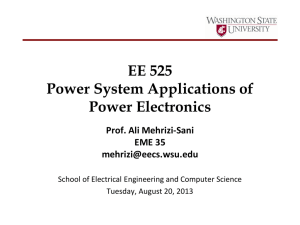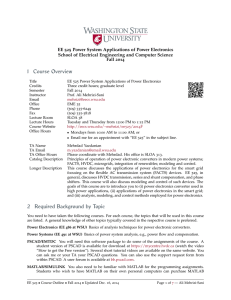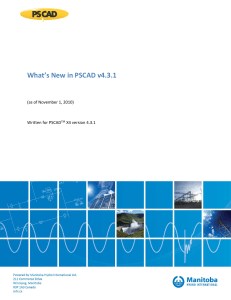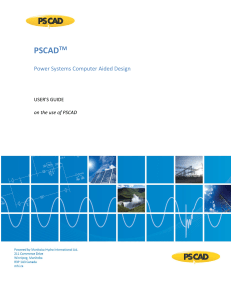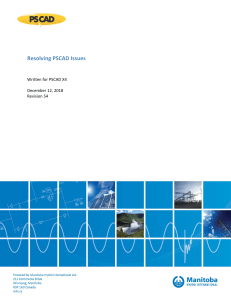Power System Applications of Power Electronics, Fall 2013
advertisement
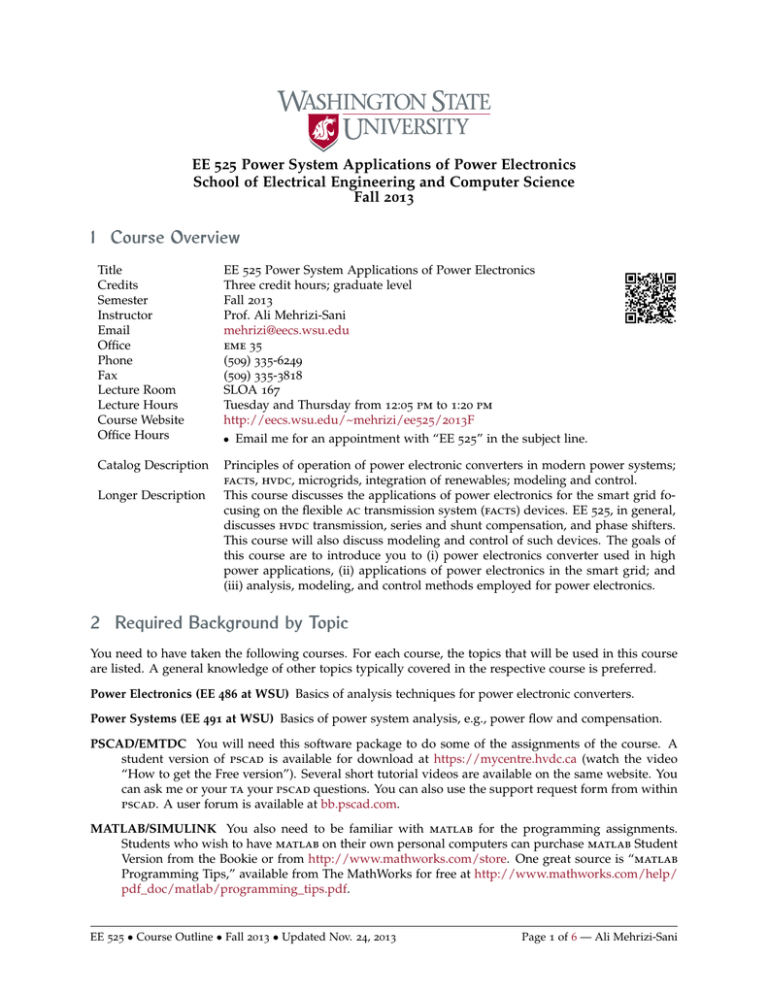
EE 525 Power System Applications of Power Electronics School of Electrical Engineering and Computer Science Fall 2013 1 Course Overview Title Credits Semester Instructor Email Office Phone Fax Lecture Room Lecture Hours Course Website Office Hours Catalog Description Longer Description EE 525 Power System Applications of Power Electronics Three credit hours; graduate level Fall 2013 Prof. Ali Mehrizi-Sani mehrizi@eecs.wsu.edu eme 35 (509) 335-6249 (509) 335-3818 SLOA 167 Tuesday and Thursday from 12:05 pm to 1:20 pm http://eecs.wsu.edu/~mehrizi/ee525/2013F • Email me for an appointment with “EE 525” in the subject line. Principles of operation of power electronic converters in modern power systems; facts, hvdc, microgrids, integration of renewables; modeling and control. This course discusses the applications of power electronics for the smart grid focusing on the flexible ac transmission system (facts) devices. EE 525, in general, discusses hvdc transmission, series and shunt compensation, and phase shifters. This course will also discuss modeling and control of such devices. The goals of this course are to introduce you to (i) power electronics converter used in high power applications, (ii) applications of power electronics in the smart grid; and (iii) analysis, modeling, and control methods employed for power electronics. 2 Required Background by Topic You need to have taken the following courses. For each course, the topics that will be used in this course are listed. A general knowledge of other topics typically covered in the respective course is preferred. Power Electronics (EE 486 at WSU) Basics of analysis techniques for power electronic converters. Power Systems (EE 491 at WSU) Basics of power system analysis, e.g., power flow and compensation. PSCAD/EMTDC You will need this software package to do some of the assignments of the course. A student version of pscad is available for download at https://mycentre.hvdc.ca (watch the video “How to get the Free version”). Several short tutorial videos are available on the same website. You can ask me or your ta your pscad questions. You can also use the support request form from within pscad. A user forum is available at bb.pscad.com. MATLAB/SIMULINK You also need to be familiar with matlab for the programming assignments. Students who wish to have matlab on their own personal computers can purchase matlab Student Version from the Bookie or from http://www.mathworks.com/store. One great source is “matlab Programming Tips,” available from The MathWorks for free at http://www.mathworks.com/help/ pdf_doc/matlab/programming_tips.pdf. EE 525 • Course Outline • Fall 2013 • Updated Nov. 24, 2013 Page 1 of 6 — Ali Mehrizi-Sani 3 Learning Outcomes At the end of this course, you are expected to be able to • Explain the purpose and principles of operation of facts devices; • Analyze the nonsinusoidal voltage and/or current resulting from a facts device; • Compare and contrast different compensation methods (series, shunt, hybrid, and phase); • Analyze the steady-state operation of a vsc and harmonic elimination techniques; • Design a controller for a vsc based on application, e.g., a statcom application; • Derive the dynamic model of a given facts device; and • Compare different modes of operation of a microgrid based on available standards. 4 Course Topics The course topics include • Course overview • Review of power electronics • Review of steady-state power flow • Applications of converters for compensation of transmission systems, e.g., shunt, series, and hy- brid compensation, such as switched capacitor, static synchronous compensator (statcom), static var compensator (svc), thyristor-controlled reactor (tcr), thyristor-controlled series capacitor (tcsc), thyristor-switched series capacitor (tssc), static synchronous series compensator (sssc), unified power flow controller (upfc), and interphase power flow controller (ipfc). • High-voltage direct current (hvdc) systems • Wind power systems (time permitting) • Converter dynamic model and control, reference frames • Microgrids and integration of distributed energy resource (der) units Below is the approximate course schedule (the text in crimson and green are hyperlinked). Important dates are also marked. Because of the necessary travel, we will have a few make-up classes on Thursday evenings (marked below as EVE) at 5:15 pm, unless otherwise stated. The make-up classes will be held in the same classroom. To download pscad simulation cases, click on the green link and then press Ctrl-S (Save) in your browser. Make sure the file is saved with an extension of .pscx, and not .pscx.txt. W1 Aug. 20 Topic Reading and Notes T Overview of the course and policies T Slides. R Review of power system/electronics; R LATEX resources (Gettig something out of overview of series compensation LATEX; LATEX Wikibook; The Art of LATEX; A (not so) Short Introduction to LATEX; TEX StackExchange; TikZ graphics in LATEX) W2 Aug. 27 W3 Sept. 3 T Intro to pscad/emtdc T pscad Overview of shunt compensation; vsc |BuckConverter T pscad EVE Make-up for Aug. 29 |BuckConverterSine R No class—EPRI HVDC/FACTS Conf. T Voltage-sourced converters; pwm R vsc square-wave; multilevel; MMC pscad/emtdc simulation of half- and full-bridge (uni- and bipolar) EE 525 • Course Outline • Fall 2013 • Updated Nov. 24, 2013 pscad EVE Make-up for Sept. 10 (on Tues, Sept. 3) R Hart §8; Hingorani §3; pscad Week |PWMinverter |FullAndHalfBridge Page 2 of 6 — Ali Mehrizi-Sani W4 Sept. 10 T No class—Microgrid Symposium T Homework 1 R No class—Microgrid Symposium W5 Sept. 17 T Line models T Mathur §2; Stevenson $6 R Shunt compensation R Mathur §2 EVE Make-up for Sept. 12 transient stab. EVE Hingorani §5 W10 Oct. 22 T Project Proposal Due |TCR R tsc; comparison of svc R EVE T Control of shunt compensators T Homework 2 R Series compensation R First paper on gcsc, 1993: Continuously EVE Make-up for Nov. 15 gcsc, tcsc W9 Oct. 15 EVE T pscad simulation of tcr; tsc-tcr EVE Make-up for Nov. 12 statcom W8 Oct. 8 R Mathur §3 R fc-tcr EVE Make-up for Oct. 29 W7 Oct. 1 T Homework 1 due Hingorani §5 T tcr operation and harmonics pscad W6 Sept. 24 regulated series capacitor by Karady et al. EVE ieee Paper: Comparison of gcsc and tcsc T sssc T Course: Power Semiconductor Devices R Phase shifters R T Guest Lecturer: Prof. Reza Iravani T Homework 3 Homework 2 due (UToronto); ETRL 101 (at 11:00) R W11 Oct. 29 W12 Nov. 5 W13 Nov. 12 R T No class—NAE FOEE R No class—WSU-ASU Game: no afternoon classes T T Homework 3 due R R T No class—IECON 2013 R No class—IECON 2013 W14 Nov. 19 W∗ Nov. 26 W15 Dec. 3 Final T VSC Modeling and frames R VSC Modeling Thanksgiving break T Homework 4 R T Application case study T R Review and recap R Project Report Due Final Exam,1 Friday, Dec. 13, 2013 8:00 AM to 10:00 AM 1 http://www.registrar.wsu.edu/Registrar/Content/FinalExams20133.pdf 5 Textbook No textbook is required. The following are good references for facts. EE 525 • Course Outline • Fall 2013 • Updated Nov. 24, 2013 Page 3 of 6 — Ali Mehrizi-Sani 1. R. M. Mathur and R. K. Varma, Thyristor-Based FACTS Controllers for Electrical Transmission Systems. New York, NY: Wiley-IEEE Press, 2002. [Online]. Available: http://ieeexplore.ieee.org/ xpl/bkabstractplus.jsp?bkn=5265762 2. N. G. Hingorani and L. Gyugyi, Understanding FACTS: Concepts and Technology of Flexible AC Transmission Systems. New York, NY: Wiley-IEEE Press, 2000. [Online]. Available: http://ieeexplore.ieee. org/xpl/bkabstractplus.jsp?bkn=5264253 3. A. Yazdani and R. Iravani, Voltage-Sourced Converters in Power Systems: Modeling, Control, and Applications. New York, NY: Wiley-IEEE Press, 2010. [Online]. Available: http://washingtonstate.worldcat. org/oclc/609861255 The following are useful references for power electronics: 1. H. Akagi, E. H. Watanabe, and M. Aredes, Instantaneous Power Theory and Applications to Power Conditioning. Hoboken, NJ: IEEE-John Wiley, 2007. 2. D. W. Hart, Power Electronics. New York: McGraw-Hill, 2011, 512 pp. 3. M. H. Rashid, Ed., Power Electronics Handbook: Devices, Circuits, and Applications, 3rd ed. Burlington, MA: Elsevier, 2011, 1417 pp. 4. Y. H. Song and A. T. Johns, Eds., Flexible AC Transmission Systems (FACTS). Institution of Electrical Engineers, 1999. London, UK: The 6 Evaluation Your performance in this course will be assessed based on the components shown below. Failure to complete assigned work or to take a test results in a zero for that portion of your grade, unless you have a compelling reason because of an emergency. For submission format, see Subsection 6.1. Assignments (40%) Approximately 4 assignments. Generally you will have about two weeks to work on each assignment. Each assignment report has to be submitted electronically by the midnight of the due date (typically Wednesdays) through the course website. Please try all assignments; they will help you in preparing for the final exam. Extra credit may be given for an extraordinary assignment at the discretion of the instructor, e.g., solving bonus problems, an elegant solution, a comprehensive discussion, or an especially neat and tidy submission. Final Project (30%) See Subsection 6.2 below. Final Exam (30%) Two-hour comprehensive exam. Class Participation (0%) But class attendance is required and no more than three absences will be allowed, unless with prior permission. Class participation can help you when in the boundary of letter grades. 6.1 Letter Range A A− B+ B B− C+ C C− D F [90, 100] [85, 90) [80, 85) [75, 80) [70, 75) [65, 70) [60, 65) [55, 60) [50, 55) [0, 50) Submission Format For all work in this course (e.g., assignment and project) that needs preparing a written document, the following guidelines will be strictly enforced. All submission have to be electronic (only pdf files are accepted) and through the course webiste. Name the file according to the following pattern: EE525_???_Lastname_Firstname.PDF, where ??? is “HW#,” “PRJ,” or “PRP,” for homework assignment, project report, or project proposal, respectively. The report must be in ieee double-column style. Both TEX and Word templates are available on ieee Author Digital Toolbox at http://www.ieee.org/publications_standards/publications/authors/authors_ EE 525 • Course Outline • Fall 2013 • Updated Nov. 24, 2013 Page 4 of 6 — Ali Mehrizi-Sani journals.html. You can choose between Word and LATEX (or other tools), but to encourage producing beautiful technical documents, submissions that use LATEX will receive 5% bonus (mark+ = 5%). Late submissions are accepted but marked at 20% reduction per day unless there is valid justification; that is, one day late: maximum mark 80%, two days: 60%, three days: 40%, four days: 20%, and five days: 0%. You may discuss your work with your fellow students, but each person has to submit a separate and original report. 6.2 Final Project The final project is an important part of this course. The project is where you apply the analysis methods covered in class to a design problem, which will have a significant simulation component. Please start thinking about the project early. Ideally you would select a project related to your thesis; I suggest you discuss your project with your supervisor to select a relevant topic. I do not require a “novel” contribution, but any innovation that leads to publishable material will guarantee a full mark for the project. Depending on the scope of the project, you can form teams of up to two people. The project report describes your design, identifies challenges, and includes simulation cases in pscad. The project topics can include • Case study, e.g., harmonics due to shunt compensation; • Performance evaluation, e.g., effects of series compensation on mechanical modes; • Design, e.g., design of controllers for an electronically interfaced der unit; • Reproducing the results in a published Transactions paper (and probably improving them); or • Any combination of the above. The project deliverables, all in pdf and communicated as described above, are as follows. Project Proposal (Due Oct. 1, 2013) The project proposal (maximum one page) includes the title and objective of your selected project. Project Report (Due Dec. 5, 2013) The project results should be included in a final report in no more than 5 pages. Similar to a standard paper, the report should include title, abstract, introduction, methodology, simulation and results, discussion, future work and conclusion, and references. The project report will be graded according to the following rubric: 70% Technical correctness Your method, simulation, and results should be technically sound. Your report should be clear and reader-friendly. 30% English and format Use standard American (not British) English. Specifically, you will be graded according to the handout “Writing in Academia” that is posted on the course website (see http://eecs.wsu.edu/~mehrizi/LIPE_WritingInAcademia.pdf). 7 Academic Integrity I encourage you to work with classmates on assignments. However, each student must turn in original work. No copying will be accepted. Students who violate wsu’s Standards of Conduct for Students will receive an F as a final grade in this course, will not have the option to withdraw from the course and will be reported to the Office Student Standards and Accountability. Cheating is defined in the Standards for Student Conduct WAC 504-26-010 (3). It is strongly suggested that you read and understand these definitions. Please also see http://academicintegrity.wsu.edu. 8 Students with Disabilities Reasonable accommodations are available for students with a documented disability. If you have a disability and need accommodations to fully participate in this class, please either visit or call the Access EE 525 • Course Outline • Fall 2013 • Updated Nov. 24, 2013 Page 5 of 6 — Ali Mehrizi-Sani Center (Washington Building 217; (509) 335-3417; Access.Center@wsu.edu) to schedule an appointment with an Access Advisor. All accommodations MUST be approved through the Access Center. For more information, see http://accesscenter.wsu.edu. 9 Safety and Emergency Notification Washington State University is committed to enhancing the safety of the students, faculty, staff, and visitors. It is highly recommended that you review the Campus Safety Plan (http://safetyplan.wsu.edu) and visit the Office of Emergency Management web site (http://oem.wsu.edu) for a comprehensive listing of university policies, procedures, statistics, and information related to campus safety, emergency management, and the health and welfare of the campus community. 10 Disclaimer Information contained in this document may and will change as required during the semester. Such changes will be communicated to you via email, in class, and/or on the website. Please make sure you attend all lectures to stay up-to-date. Most course material, e.g., assignments, grades, and extra readings, will be communicated through the website. I encourage you to discuss any difficulties you may have in this course with me or with your ta. EE 525 • Course Outline • Fall 2013 • Updated Nov. 24, 2013 Page 6 of 6 — Ali Mehrizi-Sani
